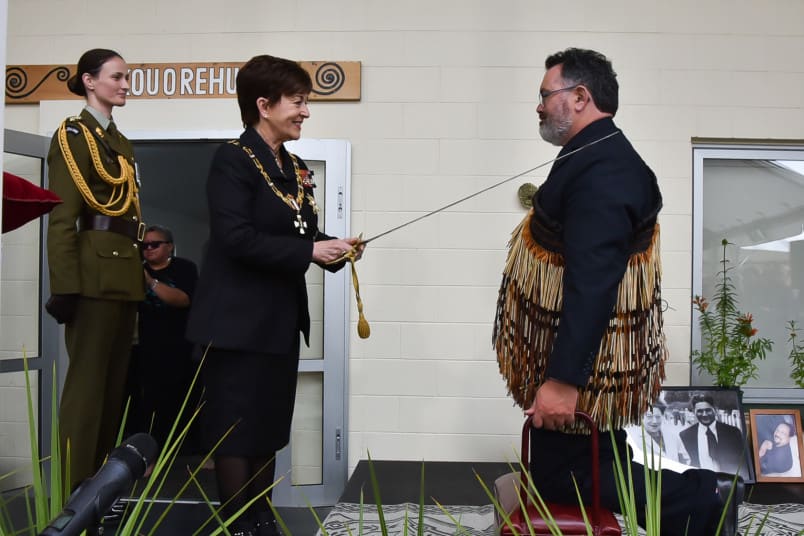
Philip Temple on the "good faith" Treaty
We are told almost daily that we should observe the “Principles of the Treaty of Waitangi”, whether this is in the context of government legislation or in the revised constitutions of incorporated societies. It has become a mantra that eclipses that of our national hymn, “God Defend New Zealand”. But where that has always been symbolic, and its prayer indifferently answered, observing and applying the “Principles” has become politically mandatory. And only principles derived from the Māori version of the Treaty. Is there a difference between that and the English version?
There have been numerous past commentaries on the English text of the Treaty and its origins, and from which the Māori translation was drawn, but nothing as detailed and comprehensive as the research and analysis resulting in the newly published, massive 730-page volume, The English Text of the Treaty of Waitangi. The book was developed by lawyer Ned Fletcher from the thesis he prepared for his PhD in 2014. So, unsurprisingly, he follows the legal and bureaucratic paper trail from as far back as the origins of the British Empire and its early dealings with indigenous peoples.
The world of the Treaty here consists of five continents of evidence and argument. The first to be explored is the growth of “The British Empire” and the development of its dealings with indigenous peoples in different colonies (95 pages). The second exploration shows "The path to British intervention in New Zealand” (140 pages) in which our first (hapless) hero, James Busby, British Resident from 1833, confers and negotiates with Māori in the north with limited success because he had neither money nor personnel granted by his bosses in New South Wales. But he managed to engineer the loose Confederation of the United Tribes of New Zealand and have its flag and the principle of sovereignty recognised. During the seven years leading up to the Treaty he also learned a great deal about Māori language, custom and behaviour and, when it came to be written in February 1840, he knew enough to be responsible for Article Two.
Our chief hero, however, is James Stephen, Permanent Under Secretary at London’s Colonial Office from 1836 to 1848 who appears first on page 104 and who is the principal guide on “The Path to British intervention” and never leaves us as chief advocate and policy maker through “Making a Treaty” (85 pages) and the final area to be explored, "Contesting the Treaty”(140pp). All of this leads to Ned Fletcher’s “Conclusion” (45 pages) which is, no spoiler here, that the Treaty “was conceived, written and affirmed in good faith” and represented "James Stephen’s considerable experience of Empire and the intellectual ideas of 1839.” This is followed by nearly 200 pages of Appendices.
Treaty policy maker James Stephen “once smoked a cigar and found it so delicious that he never smoked again”
Stephen was a distinguished legal and ecclesiastical scholar, deeply religious, an abolitionist and held a strong belief in the need to protect aboriginal peoples from the worst effects of British colonisation. In all of this he was sympathetic to the pressing views of the missionary societies. An ascetic by temperament, it was said that Stephen “once smoked a cigar and found it so delicious that he never smoked again”. He worked ten-hour days, six days a week, did not delegate and read every letter or minute that came his way. Fletcher writes, “He was central to everything the department did. Secretaries of State did not have to follow his advice, but as it was always principled, grounded on experience, elegantly expressed and carefully thought through, most did."
Elsewhere, Fletcher has said that Stephen was in a “class of his own… a civil servant of the highest calibre. He was a man of high intelligence, vast experience, wise judgment and he had a strong moral compass.” No wonder that people with a weaker moral compass, such as Edward Gibbon Wakefield, called him and his missionary colleagues “The Saints” and, for his dominating political role, “King Stephen”, "Mr Over Secretary” or “Mr Mother Country.” Ministers came and went and, although they saw legislation passed, made speeches and issued instructions, it can be comfortably argued that James Stephen was the true father of the Treaty of Waitangi.
Understand that, in opening The English Text, you are about to take part as a member of the jury in a long court case as Fletcher argues back and forth in the defence of Stephen and of the values and principles he wished to see embodied in the Treaty. Later, he examines at length the two different language versions of the Treaty to establish that they reconcile and should not be interpreted separately.

Making your way through Fletcher’s detailed narrative requires stamina and is not for the faint-hearted. Prepare yourself with plenty of coffee and the occasional shot because for a general reader it seems, at times, as if one is wading through legal treacle. But it will be seen as essential reading for Treaty historians, students and lawyers, attested by the book’s endorsement by Justice Joe Williams (who wrote the Foreword), and Sir Edward Taihakurei Durie, among others. Given these honourable accolades, what are Ned Fletcher’s conclusions for the defence and what arguments might a prosecuting counsel put forward?
*
The need for some kind of Treaty was borne upon the British government by the “fatal necessity" of establishing an appropriate rule of law for the increasing number of European settlers and vagrants, law to govern both them and their interaction with Māori. In 1839 there were about 2000 of them, chiefly in the Bay of Islands and Hokianga. The New Zealand Company had also announced plans to establish settlements that involved the purchase of considerable tracts of land. James Stephen was highly conscious of the deleterious effects of European settlement on indigenous peoples. He was also aware that it was possible to have a “pluralistic" system of laws and government in colonies where the British legal system, for settlers in the minority, operated alongside the indigenous systems of the majority; in India, for example.
In guiding the preparation of instructions for a Treaty,Stephen sought to replicate this in New Zealand with over-arching sovereign laws governing non-Māori and nationwide policies on such matters as foreign affairs (don’t mention the French), shipping, trade and defence. Māori were to continue with their own systems of tribal government and be guaranteed continued ownership of their lands and other properties. But, to prevent land-sharking and unfair practices, if Māori wished to sell land they must sell to the government, at a fair price, which would then manage land sales to settlers. This was all reflected in a Treaty that had strong protection of Māori interests in mind. But in Fletcher’s narrative, the concept of “partnership” is absent and it is hard to believe that it might have been intended, given the framers underlying belief that Māori needed civilising.
There were riders to all of this. Although it was expected that Māori should continue to govern themselves in traditional ways, this excluded such practices as slavery, cannibalism, infanticide and sacrifice which were deeply repugnant to Christian “civilisation”. If iwi began fighting each other, then the governor and his staff were expected to seek to stop it by mediation. In the land question, few Māori in 1840 understood that sale meant alienation and the introduction of private property rights for settlers. There is also no evidence in this book that those drawing up the instructions in London understood the terrible disruptions to iwi rohe boundaries caused by the recent Musket Wars. That the scope for dispute between iwi or hapu over who owned what and when was infinite (and continues to this day).
There were certain realities at play, too. The British government could not find the people, the money or the will to do anything else but draw up a Treaty that affirmed Māori sovereignty (rangatiratanga) over their lands while finding a formula that allowed for organised settlement. The Treaty was essentially pragmatic. As a British minister commented a few years after the Treaty signing, Māori were “well armed and warlike” and outnumbered settlers by ten to one. There were no other options. Lack of resources for the governors can be demonstrated by the fact that missionary printer William Colenso had to wait 18 months to be paid for printing the Treaty and government declarations.
The Treaty was not, as the New Zealand Company claimed, a “praiseworthy device for amusing and pacifying savages"
Fletcher reveals that, in approaching the issue, a sense of civilised condescension always imbued the thinking of British ministers and officials. William Hobson, after his first visit to New Zealand in 1837, described Māori as a “Fine, Manly, intelligent race, but notwithstanding the zealous exertions of our Missionaries they have made but slow advances in civilization” and they had no “form of government whatsoever." Across the board, whether James Stephen, his ministers, the missionaries or New Zealand Company people, everyone believed that Māori should be “civilised”, eventually brought into the orbit of British Christian society and institutions, whether this took five, ten or the fifty years that missionaries thought they would need.
The book tells me that there was an unrealistic expectation by the Treaty framers that it would allow settlers and Māori to live and operate separately and amicably within the same space. Ned Fletcher writes that James Stephen and his government did not appreciate the scale of settlement that would take place in the years following the Treaty, leading to settlers outnumbering Māori by 1860. Yet 58,000 had already emigrated to Australia and there were many Britons emigrating to Canada and the US. The Treaty preamble in Hobson’s own hand (reproduced in the book) refers to the “great number of Her Majesty’s subjects who have already settled in New Zealand, and the rapid Extension of Emigration from both Europe and Australia.” The Treaty was not, as the New Zealand Company claimed, a “praiseworthy device for amusing and pacifying savages for the moment” to enable British settlement. But it was an expedient device to control and manage settlement, with humanitarian but pragmatic provisions for Māori.
There seems to have been high hopes that, having found the right words, it would all work out in a reasonable and peaceful way. The road to New Zealand was paved with good intentions. This prompts, for me, an image of James Stephen, in his office at Number 11 Downing Street, writing by lamplight at the end of a very long day, at the end of a very long week, and turning wearily from his high-minded notes and advice on New Zealand - all of 12,000 miles and a three-month voyage away - to work again on his latest essay of ecclesiastical biography for the Edinburgh Review.

Ned Fletcher goes to great lengths to establish that the Treaty of Waitangi was indeed “conceived, written and affirmed in good faith.” And he argues with some success that the two versions reconcile. Yet a good deal of his evidence is qualified with the frequent use of what I call the “Probably Factor”. People in Fletcher’s narrative "may have" written, read, sent, thought or said things often enough for the jury to become a tad doubtful of his arguments.
Historian Claudia Orange wrote in her seminal text on the Treaty that, by the time James Stephen and his ministers compiled Hobson’s instructions for the Treaty, they were no longer “considering a Māori New Zealand in which a place had to be found for British settlers, but a settler New Zealand in which a place had to be found for Māori.” Fletcher firmly disagrees with this, and similar conclusions by other historians such as Ian Wards and Peter Adams, in favour of arguments for the Treaty being for the “protection of Māori” put forward by Trevor Williams (in 1940-41) and Keith Sinclair (in 1961).
Perhaps unintentionally, Fletcher clearly demonstrates to me that this was a Treaty for the needs and circumstances of its time, with no real vision of how it would play out. By 1845 the ground was already shifting. Prime Minister Robert Peel declared that the feelings about the Treaty had changed. “I do not hesitate to say that the Treaty of Waitangi has been a most unwise one, even for the natives,” and that sovereignty should have been asserted by Cook’s right of discovery and the purchase of lands negotiated with Māori. By then the Wairau conflict in 1843 had caused turbulence in Māori-settler relations in the Cook Strait region - as well as in London - and the first war had begun in the north.
So where does this book leave us now? I will conclude on a heretical note. It confirms for me that the Treaty was a document shaped for its moment in time and, given it was soon subverted, it should be treated like that other great document of its time and to which it is often compared, the Magna Carta. The Treaty is a foundational, but historical, artefact and it is time to stop arguing over its every word and meaning. As talk of a republic begins, we need to “reconceptualise” it, as one prominent constitutional lawyer has put it. It is time to begin discussing a new constitutional construction “conceived, written and affirmed in good faith”, 180-200 years on.
The English Text of the Treaty of Waitangi by Ned Fletcher (Bridget Williams Books, $69.99) is available in bookstores nationwide.







